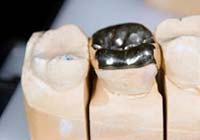Once placed, it in effect becomes the tooth's new outer surface. In comparison, a dental filling just fills in or repairs a portion of a tooth.
Dental crowns are sometimes referred to as dental caps, tooth caps, or porcelain jackets
Dental crowns are permanently cemented into place. The tooth crown unit that results is cared for and functions like any natural tooth.
Why are crowns placed?
There are a several different reasons why a dental crown might be made for a tooth. Dentists routinely use them to:
- Restoring or making changes with a tooth's shape
- Strengthening a structurally compromised tooth
- Improve the appearance of a tooth (including color, shape and even apparent alignment).
What kinds of materials are dental crowns made out of?
- Porcelain Crown (or other type of dental ceramic.)
- Metal alloy or Full Metal Crown "FMC" (a gold or other precious, semi-precious or non-precious alloy)
- A combination of dental ceramic and metal alloy (porcelain-fused-to-metal crowns)
The advantage of a crown
In some instances, it's conceivable that a dental filling might be placed as an alternative. A dental crown, however, offers a big advantage due to the way that it's constructed.
Crowns are fabricated in a dental laboratory (by a dental technician using molds your teeth). Dental Fillings, in comparison, are built right in your mouth by way of your dentist placing the filling material directly upon your tooth.
It's easier to get the "perfect" tooth shape with a crown
A dental laboratory technician gets the opportunity to simulate and examine aspects of your bite and jaw movements from a variety of angles, and then sculpt your dental crown so it has the ideal shape.
With a dental filling, the dentist has far less control over the restoration's final contours because it is often difficult for them to visualize, evaluate, or access to the tooth they're working on.





No comments:
Post a Comment